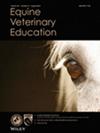Descriptive analysis of the use of and preferences for equine veterinary services
Abstract
Background
Little is known about horse owners' use of and preferences for equine veterinary services, which are key components of the financial health of equine veterinary practices and challenges facing the profession.
Objectives
The objective of this research is to describe horse owners' use of and preferences for equine veterinary services and assess their willingness to adapt to changes in delivery of services.
Study design
An online survey was used to collect data for the study. The target audience was US residents aged 18+ who were financially responsible for at least one horse, pony, mule or donkey.
Methods
The online survey was distributed through participating organisations' social media and email lists. Microsoft Excel 16 was used to tabulate summary statistics.
Results
The survey received a total of 4915 usable responses from every state in the United States. Most respondents are financially responsible for one to five horses, have a primary equine veterinarian and are visited by a veterinarian two to four times per year. Low rates of equine health savings accounts and health insurance may limit financial access to veterinary care. The majority of respondents report a willingness to accommodate deviations from traditional delivery of services. The most common maximum willingness-to-pay for annual vaccinations was $150, lameness exams was $200 and emergency colic surgery was $5000.
Main limitations
The response rate cannot be computed due to the distribution method. The representativeness of the sample cannot be determined due to lack of information on the horse owning population. In stated preference studies, hypothetical bias is common.
Conclusions
The results from this survey provide the first-known documented evidence on the utilisation of equine veterinary services in the United States, willingness to adapt to changes and willingness to pay for three sample services. These data can inform the profession on attitudes towards services provided.




 求助内容:
求助内容: 应助结果提醒方式:
应助结果提醒方式:


